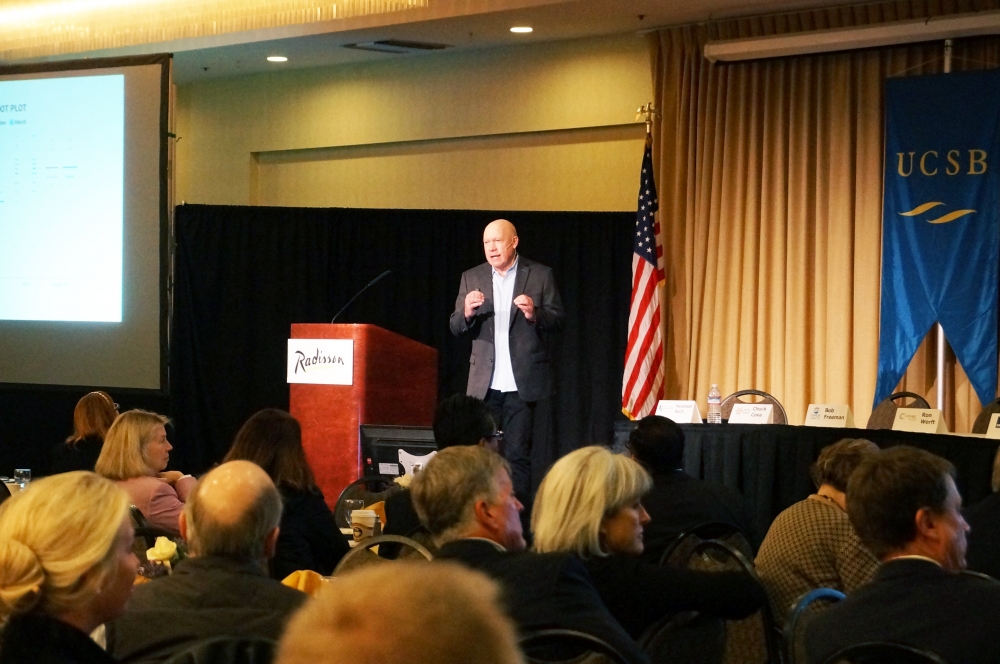Show Me the Money
Financing the health of the Santa Barbara community was the big topic at the UCSB Economic Forecast Project’s (EFP) North County Economic Summit as leaders of local healthcare organizations joined forces to put together pieces of the puzzle that is the local and regional healthcare landscape. The discussion was led by UC Santa Barbara economics professor and EFP director Peter Rupert and featured insight from Sacramento Bee columnist Dan Walters.
No groundbreaking prognostications or big final pronouncements came out of the North County summit; the fate of the Affordable Care Act (ACA) — and consequently of the health insurance of millions of previously uninsured and uninsurable Americans — still hangs in the balance at the nation’s capitol. Likewise in California, Democratic lawmakers recently forwarded a proposal for a statewide single payer system, a gamble that could technically pay off, Walters noted, if the proposal contained more meat.
“The problem always flounders on the problem of cost,” he said. Despite strong support for the proposal from certain quarters and the fact that California pays more per capita for healthcare than does Canada, which for a similar population size has a single-payer system, lawmakers haven’t mustered the will to push it through.
“They say ‘show me the money’,” Walters said of the more center-leaning Democrats, including Gov. Jerry Brown. “And so far, no one’s shown them the money.”
In fact, “show me the money” was a main theme of the discussion, as it covered local healthcare providers’ perspective on the healthcare picture in Santa Barbara, including the interlocking nature of services provided by each of the regional medical providers — Cottage Health, Lompoc Valley Medical Center, Dignity Health, as well as Medicaid-only insurance provider CenCal Health — and recent advances in major areas such as cardiac surgery, acute care, trauma and pediatrics.
Americans are spending an “unsustainable” amount of money on health, according to panel members.
“We’re spending 18 percent of our GDP on health, and we aren’t getting what we’re paying for,” said Ron Werft, President and CEO of Cottage Health, which has hospitals in the northern, central and southern regions of Santa Barbara County. In comparison to many other industrialized countries, including Japan, Australia and much of Europe, the U.S. spends $3 trillion on health only to be “at the bottom of the list” in terms of life expectancy.
Drilling deeper into the unsustainability is the fact that those with commercial insurance (as opposed to government-sponsored Medicare and Medicaid) are footing most of the bill — in the form of higher premiums — for the services provided to the overall patient population, including those who are uninsured. According to the American Public Health Association, uninsured patients are less likely to see physicians for early and preventative care, which results in higher costs when they do seek treatment. This in turn leaves commercially insured patients to cover the gaps created by people who can’t pay their medical bills. Meanwhile, particularly in Santa Barbara County, which has an aging population, more patients are shifting toward Medicare, which pays for about two-thirds of the care costs of the people it covers.
The Affordable Care Act has, in fact, decreased the number of uninsured in Santa Barbara County, primarily through the expansion of MediCal (the California version of Medicaid), which covers low-income patients. However, Werft pointed out, on the hospital side of things, the increase in state-sponsored coverage does not at the moment represent more money coming to the hospitals.
“It really is just a change in the way they’re paying,” he said. To support the ACA and get millions of Americans out of the ranks of the uninsured and into Medicaid, hospitals across the nation agreed to take $550 billion in cuts to Medicare funds in favor of future gains through more patients seeking preventative care, fewer emergency room visits and Medicaid paying for about half the costs of the previously uninsured. A major concern among hospitals as the ACA undergoes potential huge changes is if Medicaid expansion is cut and the exchanges, such as Covered California, lose the federal funding that enables individuals and small businesses to purchase government-subsidized insurance, the hospitals could wind up in a deeper hole without the restoration of the cuts they endured in the first place.
And, while the State of California, which currently boasts the sixth largest economy in the world, could, in theory, switch to a more autonomous universal single-payer system, the panelists were doubtful it could work without federal financial and political support.
Still, the broad uncertainties have not stopped the group from contemplating what could be done to make the most of the situation and deliver the best care. Among the actions recently taken is a broader view of the community’s health needs.
“We’re doing more business outside of the hospital,” said Naishadh Buch, COO of Lompoc Valley Medical Center.
This shift toward population health means an examination of trends in the health of the communities served by the several hospitals. Santa Barbara County, for instance, is generally healthier than the rest of the state in most aspects, except in the area of diagnosed clinical depression. Level of education is a huge predictor of health outcomes, as are — to a lesser extent — income and ethnicity. Collaboration, and partnerships with community health clinics are becoming more essential.
“We are forced — in a good way — to collaborate to identify best practices and opportunities to serve our community,” said Chuck Cova, senior vice president of Dignity Health, whose facilities include Marian Regional Medical Center in Santa Maria and hospitals in San Luis Obispo and Oxnard.
Innovation is playing a growing role in the ability to provide more and better healthcare. Computer- and robot-assisted technologies are delivering more precision and less invasion in procedures, while remote communication technologies are giving doctors and patients access to expertise outside the region. As part of its drive to provide quality care and recruit top-notch physicians, Cottage Health has partnered with UCSB to offer research opportunities and facilities.
The panel agreed that ultimately, improved health outcomes were the main goal, and efforts ought to be focused on bringing the different moving parts of the health financing system in line with that goal.
“What we’ve all been talking about is aligning the financial incentives for healthcare,” said CenCal Health CEO Bob Freeman, “so the hospital, the payer and the physician are all focused on the outcome of the patient without regard to the individual classification, and I think that is the key to use.”





